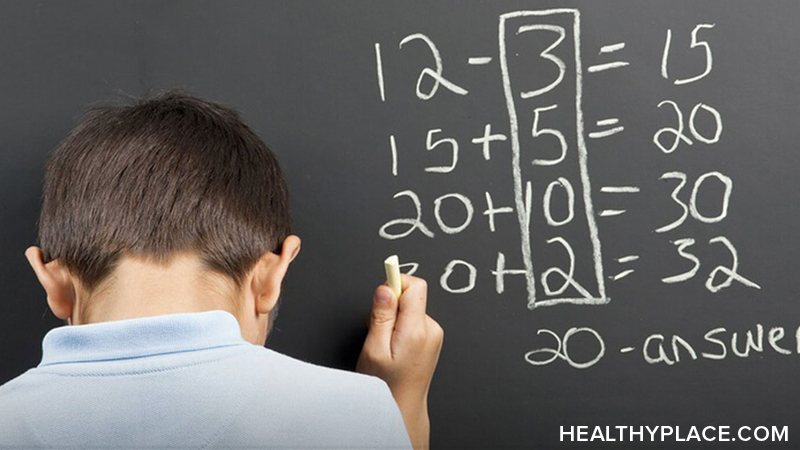How Do You Spot a Math Learning Disability?

A math learning disability can cause significant difficulties and distress in the lives of people who live with them. Officially known as specific learning disorder with impairment in mathematics or as dyscalculia, this learning disability isn’t as well known as dyslexia, a reading learning disability. Yet dyscalculia affects about five to seven percent of students in the United States (Frye, n.d.). Math learning disability involves all things related to calculations, concepts, and processing. If you are concerned about your child, how can you tell if it’s just common math struggles that will improve with practice or if it’s a math learning disability? Let’s look at some information that will help you spot a disability.
Know what You’re Looking for: Math Learning Disability Symptoms and Signs
Even if you don’t use math in your job or your idea of doing math is using the calculator app on your phone sometimes, you use math skills all the time. So do kids, including those with dyscalculia. Having to use math in and out of school can be highly frustrating and can make these kids avoid all things math or have meltdowns when faced with doing math and math-related activities.
In addition to this emotional frustration, there are other signs and symptoms that point to dyscalculia learning disability. Your child’s teacher might notice these school-based math difficulties:
- Struggles with counting
- Problems memorizing and recalling basic math facts, such as addition rules or multiplication tables
- Having a hard time putting numbers in the right columns to calculate them
- Difficulty grasping mathematical symbols (that “+” means add, for example)
- Problems with understanding fractions
- Trouble making connections between numbers and amounts, symbols and directions, etc.
- Using fingers to count long after classmates moved past that tool
- Hard time reading clocks, telling time
- Difficulties grasping the concept of time
- Money trouble, as in difficulty understanding the concept of amounts of money, giving a clerk at a store the right amount of money, problems with counting change
- Problems measuring distance, size, amounts
- Hard time knowing left from right
- Difficulties recognizing patterns and sequencing numbers
- Can’t fully grasp concepts like more and less, bigger and smaller, first, second, third (also known as number sense)
At home, where math reasoning and conceptualizing continues, you might notice your child struggling with things like:
- Memorizing and recalling phone numbers, including their own
- Memorizing their address and understanding the meaning of an address
- Knowing how much their allowance money is
- Judging distance, such as how far they will ride their bike from home to the park they’ve been to many times
- Conceptualizing how much time something will take, what “Be home by 7:00” means, or how to “Come down for dinner in 10 minutes.”
- Finding it hard to remember directions to a friend’s house
- Making measuring mistakes when baking with you
- Disliking number or counting games or games that need constant scorekeeping
Math involves so much more than doing worksheets in school. It’s part of everyday life, and not being able to grasp necessary concepts, concepts that most people take for granted, can cause significant anxiety.
Math Learning Disability and Anxiety
Kids with learning disabilities often feel pressured to keep up with classmates, or they feel judged as “stupid.” They can be very hard on themselves, demanding a level of performance that learning disabilities block. Often, this causes anxiety in kids.
Anxiety often creates more of itself. A child experiencing continued poor math performance develops anxiety, which interferes in their learning and leads to continued poor performance, which creates more anxiety.
Anxiety itself can worsen the effects of dyscalculia because anxiety negatively affects attention, processing speed, and memory, all crucial skills that are already compromised. Treating both anxiety and the math learning disability will help ease frustration, improve self-esteem, encourage perseverance, and help build math skills.
Math Learning Disability Treatment
An important treatment goal for any child with dyscalculia is to create a secure, steady base to build more skills. Having emotional stability and a reliable plan established in an individualized education program (IEP) will reduce anxiety and increase math-related skills. This is accomplished through patience, realistic expectations (neither too high nor too low), and individualized instruction.
Other techniques for math learning disability treatment include:
- Allowing the student to use their fingers for counting without shaming
- Permitting scratch paper
- Pairing the child with a classmate for help
- Using manipulatives as tools
- Applying rhythm and music to math problems
- Allowing daily practice on a computer
Last, but definitely not least, encourage your child. Point out their strengths, and help them see that they do have math skills and strengths. A math learning disability doesn’t mean an inability to do math or use related concepts.
APA Reference
Peterson, T.
(2022, January 17). How Do You Spot a Math Learning Disability?, HealthyPlace. Retrieved
on 2025, December 7 from https://www.healthyplace.com/parenting/learning-disabilities/how-do-you-spot-a-math-learning-disability



